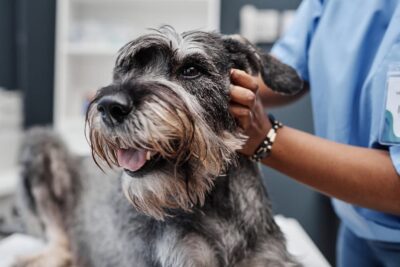5 Signs It’s Time to See a Dog Dermatologist

All featured products are chosen at the discretion of the GreatPetCare editorial team and do not reflect a direct endorsement by the author or reviewer.
Skin problems are extremely common in dogs. In fact, one study in the U.K. showed that skin problems were the second most commonly seen issue in dogs, after dental problems (1).
As a vet myself, I agree — I would see on average one dog with a skin problem each day. The problem is, skin cases are complex and need a thorough workup to get to the bottom of the problem. My skin cases also have to compete with my vomiting cases, my heart disease cases, and emergencies that walk through the door, meaning it’s very hard to be as thorough as needed. That’s why I often recommend seeing a dog dermatologist.
Read on to learn more about dog dermatologists, the types of skin issues they treat, and signs it’s time to see one.
What Do Dog Dermatologists Do?
Dog dermatologists focus on the skin, ears, fur, and nails. They don’t have to deal with the heart problems or the vomiting, the dental problems or the emergencies, so their time and knowledge are focused on diseases of the skin. Many dog dermatologists will have extra qualifications or even be board-certified, and they’ll keep up to date with recent advancements through Continuing Education (CE) focused on skin issues.
Veterinary dermatologists see all manner of skin problems in dogs, but the most common one is allergies. Dog skin allergies are the most common skin problem our dogs suffer from, and allergies affect about 1 in 20 dogs in the U.S. (2). Dog dermatologists will see dogs with skin allergies all day, every day, and it means they have a lot of great experience. They know the recommended diagnostic steps and have access to the latest treatments, such as the newly released Zenrelia (ilunocitinib tablets). Zenrelia provides fast and effective relief for dogs with allergic itch and inflammation.

Read the entire package insert before using Zenrelia, including the Boxed Warning.
They also have longer for each patient — it’s common for dog dermatologist appointments to be an hour or even longer, to ensure they can get all the information they need.
Of course, this knowledge, experience, and extended consult time comes at a price, and dog dermatologist appointments are more expensive than your average general practitioner consultation. However, in my opinion, the dog dermatologist cost is money well-spent, as pet parents get results faster, spending less money on a trial-and-error approach.
Common Dermatological Conditions in Dogs
Dog dermatologists see a wide range of skin problems in dogs. While allergies make up the bulk of their work because of how common they are, dog dermatology specialists also see:
- Allergic skin disease
- Skin infections
- Ear infections
- Hormonal diseases affecting the coat
- Nail problems, such as symmetric lupoid onychodystrophy (SLO)
- Hair loss
- Some skin tumors
- Auto-immune skin diseases, like pemphigus
- Metabolic skin problems, like nutritional deficiencies causing skin problems
When to See a Dog Dermatologist: 5 Signs It’s Time
Your veterinarian should refer you to a dermatologist if you ask, and they may also recommend referral if they’re struggling to manage your dog’s skin problems. Here are five telltale signs you should consider referral to a dermatologist for dogs:
You want to find the underlying cause
General practitioner veterinarians like myself often treat the problem in front of us, which means giving symptomatic treatment. But finding and treating the underlying cause can make a big difference to dogs who have uncomfortable dermatological conditions. If your vet is stuck in a cycle of prescribing medications without recommending diagnostic steps to find an underlying cause, then a dog dermatologist might be able to help.
You’ve done some diagnostics and hit a block
Another reason you might need to see a dog dermatologist is if your veterinarian has started diagnostic testing but has got stuck with what to do next, or is stumped by the results they’re getting. Dermatology specialists can be really helpful to go through these cases — no matter how unusual your dog’s condition is, they’ve probably seen it before.
Your dog doesn’t seem to be improving
If medications prescribed by your usual vet aren’t helping, or aren’t helping enough, a dog dermatology specialist might be a good idea. While they don’t necessarily have access to different medicines, they have experience using these medicines differently and may be able to recommend different dosing regimens to suit your dog. They’ll also go back to basics and help by diagnosing and treating the underlying cause as well as the symptoms.
Your vet doesn’t have the right equipment
Sometimes it’s as simple as your dog needing a particular bit of equipment for a diagnostic test or treatment, for example a video otoscope for ear exams. If your usual veterinarian doesn’t have this piece of equipment, a referral to a nearby dog dermatologist may be what your dog needs. This also goes for intradermal allergy testing, as the allergen vials are not necessarily held by your general practice.
You want a second opinion
As a pet parent, it’s your right to ask for a second opinion. Perhaps it’s a complex case and you want another perspective or maybe you don’t agree with the treatment your vet has recommended and you want to try Zenrelia or another allergy medication. Either way, if your dog has a complex skin issue, getting this second opinion from a specialist dermatologist for dogs might be more cost-effective than getting it from another general practitioner.

Read the entire package insert before using Zenrelia, including the Boxed Warning.
How to Find a Good Dog Dermatologist
If you’re going to pay more to see a dog dermatologist, you want to be assured they know what they’re doing. A board-certified dog dermatology specialist will be the most expensive, but they also have the most training and experience. They’ll usually be based in specialist referral centers, so you may have to travel some distance to your consultation. That said, some work on a peripatetic basis, meaning they move between nearby practices, to reach more pets. You can find a board-certified veterinary dermatologist with this search function from the American College of Veterinary Dermatology.
In some cases, depending on the complexity of your dog’s problems, it might be appropriate to use a general practitioner veterinarian who has a certificate or other further training in dog dermatology. These vets normally work in general practice so may be in a neighboring practice. They may not have all the necessary equipment at their disposal but are a useful step-up from your normal vet when a board-certified specialist isn’t available.
The most important thing is that you trust your dog’s dermatologist. Mutual respect and trust is necessary for all vets, but even more so with dermatology, as it’s usually a slow road to recovery and relapse is common. So, choose somebody with qualifications you’re happy with, and feel free to ask them questions before you visit to ensure you’re happy with the level of care they can offer your pet.
Dog dermatologist referral
Usually, your vet will need to refer you to a dog dermatologist, and they might be able to recommend one nearby. Once you’ve chosen one, they’ll send over your pet’s notes in advance of your consultation so the dermatologist can see what’s already been tried. That said, don’t be surprised if the dermatologist insists on re-doing some tests in order to get a complete picture themselves.
Summary
As a general practitioner vet, I often refer dogs with skin problems to a dog dermatologist. Their extensive experience and further qualifications put them in a great position to offer the best veterinary care to your dog. They also have access to equipment most vets don’t, and more time to focus on your dog’s history and symptoms. While visiting a dog dermatologist is more expensive than your usual vet, it’s often cost-effective as the underlying problem can be investigated and their wealth of experience means treatment is often more successful.
References
- O’Neill, Dan G et al. “Prevalence of commonly diagnosed disorders in UK dogs under primary veterinary care: results and applications.” BMC veterinary research vol. 17,1 69. 17 Feb. 2021, doi:10.1186/s12917-021-02775-3
- Drechsler, Yvonne et al. “Canine Atopic Dermatitis: Prevalence, Impact, and Management Strategies.” Veterinary medicine (Auckland, N.Z.) vol. 15 15-29. 13 Feb. 2024, doi:10.2147/VMRR.S412570









